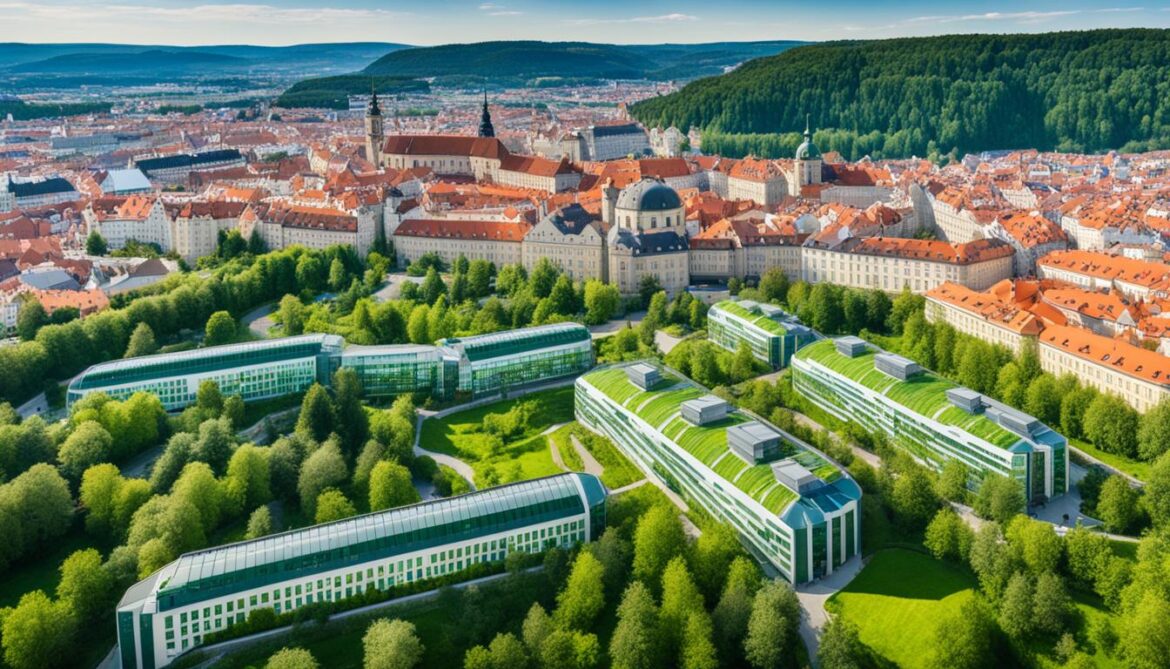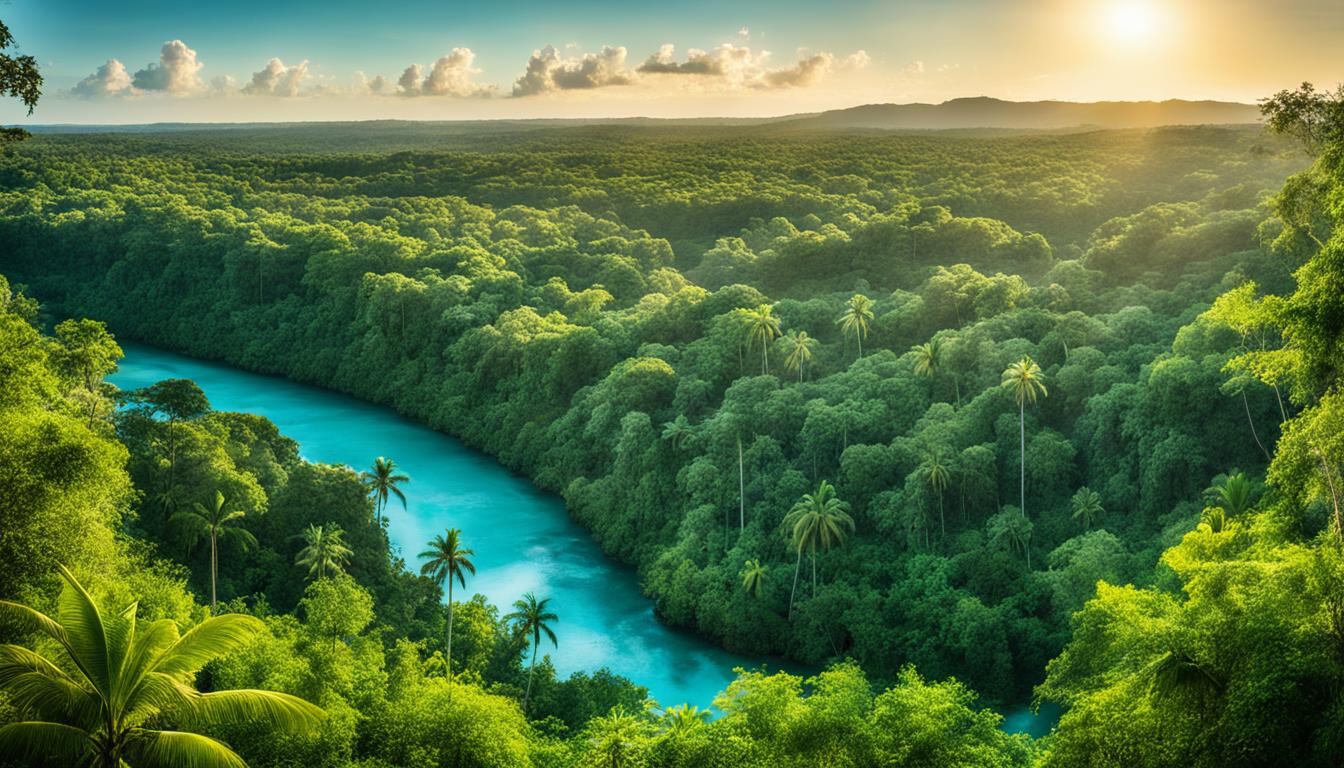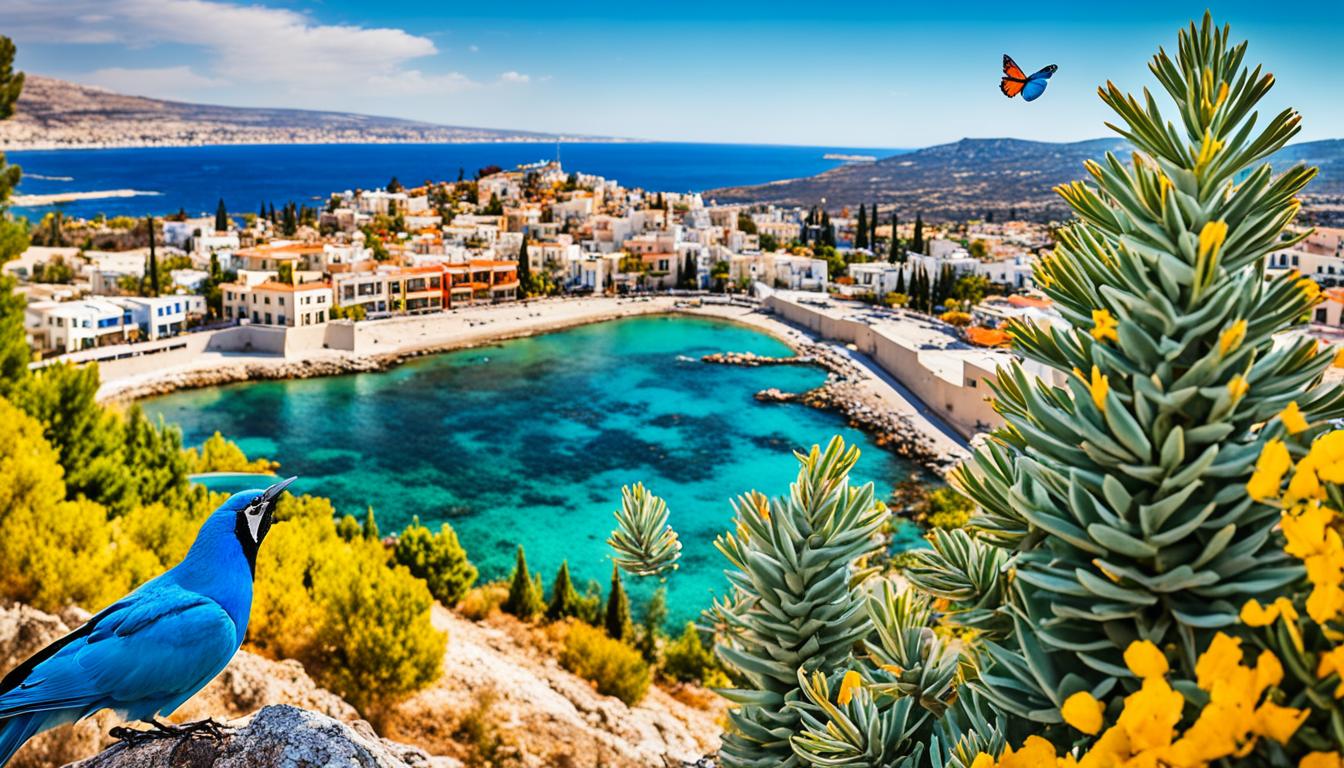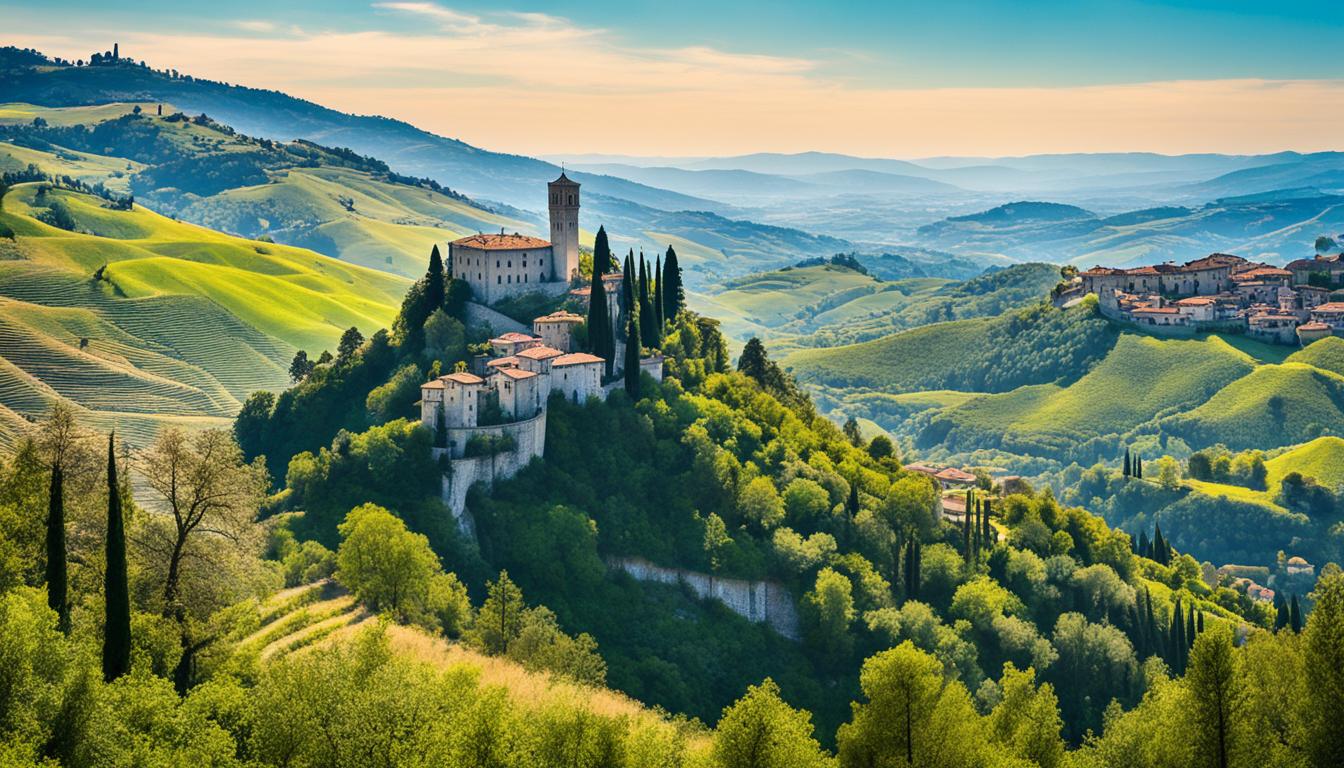Czechia Biodiversity and the Built Environment
Welcome to our article on Czechia’s efforts to promote biodiversity conservation and sustainable practices within the built environment. With a focus on sustainable architecture, urban planning, and green infrastructure, Czechia is taking significant steps towards creating ecologically sensitive designs and sustainable urban development. Let’s explore the initiatives, policies, and projects that contribute to the preservation of biodiversity and the integration of green building practices in Czechia.
Key Takeaways
- Czechia has implemented policies and strategies to promote biodiversity conservation and sustainable practices in the built environment.
- The Ministry of Environment and Regional Authorities play a vital role in developing and implementing environmental laws and policies.
- The National Biodiversity Strategy and the Act on Nature Conservation and Landscape Protection set priorities for conservation and sustainable use of biodiversity.
- Czechia participates in projects aimed at integrating green infrastructure into urban planning and transportation systems.
- Sustainable architecture, green building practices, and ecologically sensitive design are key elements of Czechia’s sustainable urban development.
Policy Setting for Green Infrastructure in Czechia
In Czechia, the Ministry of Environment and Regional Authorities play a vital role in implementing environmental laws and policies that promote sustainable practices and protect the natural landscape. While there is no specific legislation solely dedicated to green infrastructure, several laws and policies mention landscape protection and ecosystem restoration, demonstrating the country’s commitment to environmental conservation.
The Nature Conservation Agency of the Czech Republic is responsible for the conservation and reclamation of ecosystems, working towards the preservation of biodiversity. The agency collaborates with regional authorities and other stakeholders to ensure the sustainable use of natural resources and to promote the restoration of degraded ecosystems.
The National Biodiversity Strategy of the Czech Republic outlines priorities for biodiversity conservation and sustainable use, guiding policies and actions to safeguard the country’s natural heritage. This strategy emphasizes the importance of protecting and restoring ecosystems, as well as promoting the sustainable use of biodiversity in various sectors.
The Act on Nature Conservation and Landscape Protection is another key policy that highlights the significance of preserving Czechia’s natural environment. This act distinguishes between general site and species protection and special site and species protection, providing a legal framework for the conservation and management of important natural areas and rare species.
The Territorial System of Ecological Stability of the Landscape, included in the Nature and Landscape Protection Act, plays a critical role in landscape protection and the connectivity of ecosystems. This system aims to preserve and restore ecological stability, ensuring the long-term functioning of ecosystems and the services they provide.
Quotes:
“The Ministry of Environment and Regional Authorities in Czechia work together to implement policies that protect the natural environment and promote sustainable practices.” – Ministry Spokesperson
“The National Biodiversity Strategy and the Act on Nature Conservation serve as important tools for preserving Czechia’s unique ecosystems and biodiversity.” – Nature Conservation Agency Representative
Environmental Policies and Acts related to Green Infrastructure in Czechia
| Policy/Act | Objective |
|---|---|
| National Biodiversity Strategy | Set priorities for biodiversity conservation and sustainable use |
| Act on Nature Conservation and Landscape Protection | Distinguish between general and special site and species protection |
| Territorial System of Ecological Stability of the Landscape | Focus on the conservation and restoration of ecosystems and their connectivity |
Implementation of Green Infrastructure in Czechia
Czechia has been actively implementing green infrastructure measures across various sectors to promote biodiversity conservation and sustainable practices. These initiatives contribute to the overall preservation of the country’s natural environment.
The implementation of green infrastructure in Czechia is supported by the EU Natura 2000 network. Covering approximately 14% of the national area, Natura 2000 sites, including Special Protection Areas (SPAs) and Special Conservation Areas (SCIs), play a crucial role in protecting biodiversity and habitats.
| Sector | Green Infrastructure Measures |
|---|---|
| Agriculture | Efforts have been made to increase biodiversity in agricultural landscapes through subsidy programs. These programs incentivize farmers to adopt sustainable practices that enhance ecosystem health and support the conservation of natural resources. |
| Forestry | Forestry management in Czechia focuses on sustainable practices and the protection of forest ecosystems. This includes responsible harvesting methods, reforestation initiatives, and the preservation of natural habitats within forested areas. |
| Urban Policy | Urban policy in Czechia incorporates funding programs for green initiatives, such as the implementation of green roofs. These programs aim to enhance biodiversity in urban areas and improve the overall environmental quality of cities. |
| Spatial Planning | The Territorial System of Ecological Stability is integrated into spatial planning in Czechia. This system ensures that landscape protection is considered during the planning and development of urban and rural areas, promoting the preservation of biodiversity. |
By integrating green infrastructure into various sectors, Czechia strives to maintain ecological balance, protect habitats, and promote sustainable development.

Mainstreaming Green Infrastructure in Czechia
Czechia is dedicated to mainstreaming green infrastructure across various sectors to promote nature protection, sustainable development, and enhance urban planning. The country recognizes the importance of integrating green infrastructure measures to create environmentally-friendly and resilient built environments.
Nature protection is a key focus in Czechia’s efforts to mainstream green infrastructure. Through the implementation of the National Biodiversity Strategy and the Act on Nature Conservation and Landscape Protection, the country aims to increase the coverage of protected areas. This commitment ensures the preservation of valuable ecosystems and habitats.
Urban planning plays a significant role in incorporating green infrastructure into the development of cities in Czechia. By integrating green building practices and adopting ecologically sensitive design principles, the country aims to enhance the sustainability of urban areas and create healthier, more livable communities.
Czechia also actively participates in international projects that aim to integrate green infrastructure into transportation systems. By collaborating with other countries, the country is able to exchange knowledge and implement best practices in sustainable development.
“Integrating green infrastructure is essential for ensuring the long-term well-being of both urban areas and natural ecosystems in Czechia.”
Overall, Czechia’s commitment to mainstreaming green infrastructure demonstrates its dedication to nature protection, sustainable development, and creating more resilient built environments. By incorporating green infrastructure measures into various sectors, Czechia is working towards a greener and more sustainable future.

Example table: Benefits of Mainstreaming Green Infrastructure in Czechia
| Benefits | Description |
|---|---|
| Improved Air Quality | Green infrastructure helps reduce air pollution by absorbing and filtering pollutants, resulting in cleaner and healthier air. |
| Enhanced Biodiversity | By incorporating green spaces and preserving natural habitats, green infrastructure supports a diverse range of plant and animal species, contributing to biodiversity conservation. |
| Climate Regulation | Green infrastructure helps regulate temperature by providing shade, reducing the urban heat island effect, and acting as carbon sinks. |
| Flood Mitigation | Green infrastructure, such as green roofs and rain gardens, helps absorb and retain rainwater, reducing the risk of flooding in urban areas. |
| Improved Quality of Life | Access to green spaces and nature improves the well-being and mental health of residents, creating healthier and happier communities. |
Green Infrastructure and Nature Conservation in Czechia
Czechia recognizes the value of green infrastructure in nature conservation. The Natura 2000 network, which covers a significant portion of the national area, plays a crucial role in protecting habitats and species. The country has implemented measures for both general site and species protection, as well as special site and species protection. These measures aim to conserve and improve the state of sites, promote ecosystem resilience, and protect important landscape components. The conservation and restoration of ecosystems through green infrastructure initiatives contribute to the overall preservation of biodiversity.
Czechia’s commitment to nature conservation is evident in its efforts to protect and enhance the country’s natural heritage. The Natura 2000 network is a cornerstone of these efforts, encompassing a wide range of habitats and species of European importance. It includes Special Areas of Conservation (SACs) and Special Protection Areas (SPAs), which are designated for the protection of habitat types and species listed in the EU Habitats and Birds Directives.
Through the implementation of green infrastructure, Czechia aims to safeguard and restore ecosystems, ensuring the long-term protection of habitats and species. This includes the creation of wildlife corridors, the restoration of wetlands, and the establishment of protected areas. The integration of green infrastructure into planning and development processes facilitates habitat protection and enhances biodiversity conservation.
The Importance of Natura 2000 in Czechia
Natura 2000 plays a vital role in conserving Czechia’s natural heritage. It provides a framework for the protection and management of key habitats and species, ensuring their long-term survival. The network’s extensive coverage allows for the preservation of a wide range of ecosystems, from forests and grasslands to wetlands and rivers. By connecting and protecting these habitats, Natura 2000 contributes to the maintenance of biodiversity and the ecological integrity of Czechia.
Habitat Protection and Restoration
Green infrastructure initiatives in Czechia prioritize the protection and restoration of habitats. This includes the preservation of diverse ecosystems such as forests, meadows, and wetlands to ensure the survival of numerous plant and animal species. Restoration efforts focus on enhancing degraded areas and reestablishing ecological processes, leading to improved habitat quality and increased biodiversity.
One notable example of habitat protection and restoration in Czechia is the ongoing conservation of the Sumava National Park. This park, located in the Bohemian Forest, is recognized as a UNESCO Biosphere Reserve and is home to a wide range of species. Efforts to protect and restore the park’s unique habitats include the establishment of buffer zones, the removal of invasive species, and the promotion of sustainable land management practices.
Species Protection and Management
Czechia is committed to the protection and management of species through the implementation of targeted conservation measures. These measures aim to address the specific needs of endangered species and ensure their survival in the long term. The country’s approach to species protection includes habitat management, population monitoring, and the implementation of species-specific conservation programs.
One species that has benefited from conservation efforts in Czechia is the European pond turtle (Emys orbicularis). This species, listed as globally vulnerable, has seen its population decline due to habitat loss and fragmentation. In response, conservation initiatives have focused on habitat restoration, the creation of protected areas, and public awareness campaigns to promote responsible land use practices.

Sustainable Architecture and Urban Planning in Czechia
Czechia is at the forefront of promoting sustainable architecture and urban planning practices to create environmentally friendly and resilient built environments. The Ministry of Environment has taken proactive measures by launching funding programs to support green initiatives within the construction sector. One such initiative is the implementation of green roofs, which not only provide a sustainable solution but also enhance the aesthetic appeal of buildings.

The Czech Green Roof Association has played a pivotal role by developing the Green Roof Code of Practice. This code ensures the quality and effectiveness of green roof projects, emphasizing the use of sustainable materials and practices. By implementing green roofs, Czechia aims to reduce the carbon footprint of buildings, improve energy efficiency, and enhance biodiversity within urban areas.
The Importance of Sustainable Urban Development
Sustainable urban development is a top priority in Czechia’s urban planning policies. The focus is on creating energy-efficient cities with effective waste management systems. By integrating green spaces into urban areas, Czechia aims to enhance the overall well-being of its residents and mitigate the effects of urban heat islands.
“Sustainable urban development is the key to creating vibrant and livable cities. By incorporating green infrastructure into urban planning, we can create sustainable communities that prioritize the well-being of both humans and the environment,” says Petra Nováková, an urban planner and sustainability expert.
Czechia’s commitment to sustainable urban development includes the establishment of green spaces such as parks, gardens, and urban forests. These green areas not only provide recreational spaces for residents but also play a vital role in biodiversity conservation, air quality improvement, and climate regulation.
Research has shown that access to green spaces has a positive impact on mental health and overall quality of life. By prioritizing sustainable urban development, Czechia is creating a healthier and more resilient environment for its citizens.
The Role of Green Building Practices
Green building practices are an integral part of sustainable architecture and urban planning in Czechia. The use of sustainable materials, energy-efficient designs, and renewable energy sources is encouraged in construction projects to minimize the environmental impact and promote long-term sustainability.
Public and private entities in Czechia are increasingly adopting green building certifications such as LEED (Leadership in Energy and Environmental Design) and BREEAM (Building Research Establishment Environmental Assessment Method). These certifications recognize buildings that meet high standards of sustainability and energy efficiency.
| Green Building Certification | Description |
|---|---|
| LEED | A globally recognized certification that assesses the sustainable design, construction, and operation of buildings. |
| BREEAM | An assessment method that evaluates the environmental performance of buildings and promotes sustainable development. |
| Passivhaus | A standard for energy efficiency in buildings, focusing on airtight construction and mechanical ventilation. |
The adoption of green building practices not only reduces the environmental impact of buildings but also helps create healthier and more comfortable living and working spaces. Energy-efficient buildings contribute to lower energy consumption and reduced greenhouse gas emissions, leading to a more sustainable future for Czechia.
In British English, “green building practices” is also known as “eco-friendly building practices.”
Green Infrastructure Projects in Czechia
Czechia is actively involved in various green infrastructure projects aimed at enhancing biodiversity and conservation efforts. These projects contribute to the overall conservation and enhancement of biodiversity in the country, while also promoting sustainable practices. Some notable green infrastructure projects in Czechia include:
TRANSGREEN
The TRANSGREEN project focuses on integrating green infrastructure into transportation systems in the Danube-Carpathian region. By creating nature-friendly corridors and promoting ecological connectivity, this project aims to protect and enhance biodiversity across different landscapes.
Military LIFE for Nature
The Military LIFE for Nature project is dedicated to improving the conservation status of European habitats in abandoned military areas. Through habitat restoration and management, this project aims to preserve biodiversity and contribute to the revitalization of these important ecological sites.
Preservation and Expansion of Thermophilous Species Areas
Czechia also focuses on the preservation and expansion of thermophilous species areas, which are essential for supporting unique and sensitive habitats. These projects aim to protect endangered plant and animal species and ensure the long-term sustainability of these ecosystems.
Wetland Restoration
Restoration projects are underway to revitalize drained mires and create new wetland communities. These projects play a crucial role in conserving wetland habitats, supporting diverse wildlife, and improving water quality.
These green infrastructure projects demonstrate Czechia’s commitment to biodiversity conservation and sustainable development. By implementing innovative solutions and collaborating with various stakeholders, Czechia aims to create a more sustainable and resilient future for its natural environment.
Landscape Protection and Migration Corridors in Czechia
Czechia recognises the importance of landscape protection and the establishment of migration corridors to ensure the conservation of habitat and support the movement of large mammals. The Territorial System of Ecological Stability, a key component of landscape protection, plays a crucial role in maintaining ecosystem connectivity and promoting migration patterns.
Projects have been dedicated to identifying migration corridors for large mammals in Czechia and proposing protective and optimization measures to enhance their effectiveness. These initiatives aim to create a more favorable environment for the movement of species, contributing to the overall conservation of biodiversity in the country.
“The establishment of migration corridors is vital for the long-term survival of large mammals. It allows them to access different habitats, resources, and potential mates, leading to healthy populations and genetic diversity.”
Landscape Protection and Migration Corridors Projects in Czechia
Czechia has undertaken various projects focused on the identification and conservation of migration corridors for large mammals. These projects involve collaboration between environmental organizations, researchers, and local communities to ensure effective implementation.
| Project | Objective | Key Results |
|---|---|---|
| Migration Pathways for Large Mammals | To identify and protect crucial migration corridors | – Mapping of migration routes – Implementation of protective measures – Enhancement of habitat quality |
| Optimization of Migration Corridors | To enhance the efficiency and sustainability of migration routes | – Removal of barriers to movement – Restoration of degraded habitats – Collaboration with landowners and stakeholders |
| Community Engagement for Landscape Protection | To raise awareness and involve local communities in conservation efforts | – Education and outreach programs – Support for sustainable land management practices – Collaboration with nature conservation organizations |
These projects, supported by scientific research and community participation, aim to ensure the long-term viability of migration corridors and the conservation of habitat for large mammals in Czechia.

In the image above, a visual representation of migration corridors in Czechia helps emphasize the significance of landscape protection and the need to maintain and optimize these corridors for the survival and movement of large mammals.
International Collaborations on Green Infrastructure in Czechia
In order to promote green infrastructure and sustainable practices, Czechia actively collaborates with international organizations and projects. One notable collaboration is the country’s participation in the EU-funded project UNaLab. This initiative focuses on developing innovative nature-based solutions to enhance the climate and water resilience of cities. Czechia’s involvement in UNaLab demonstrates its commitment to finding sustainable and nature-inspired approaches to urban development.
Czechia also engages in collaborations related to climate and security issues through its membership in the United Nations Group of Friends on Climate and Security. By working together with other nations, Czechia aims to address the challenges posed by climate change and promote a more secure and sustainable future.
Through various initiatives and partnerships, Czechia extends its international collaborations beyond green infrastructure. These efforts encompass broader themes such as climate change, biodiversity conservation, and the integration of environmental considerations into development cooperation efforts.
International Collaborations and Their Impact
The international collaborations pursued by Czechia yield several benefits for the country and the global community. By participating in projects like UNaLab, Czechia can access and contribute to the latest advancements in green infrastructure and urban nature. The knowledge exchange and shared expertise resulting from these collaborations enable Czechia to enhance its own practices and contribute positively to sustainable urban development.
The cooperation on climate and security issues allows Czechia to actively participate in discussions and actions related to global challenges. By engaging with the United Nations Group of Friends on Climate and Security, Czechia has a platform to advocate for climate resilience, environmental protection, and the security implications of climate change.
Collaborating internationally not only enhances Czechia’s efforts to promote green infrastructure but also creates opportunities for knowledge sharing, technological advancements, and policy development in the field of sustainable development. Together, these collaborations contribute to the overall resilience and sustainability of Czechia’s built environment.
Czechia’s International Collaborations on Green Infrastructure
| Collaboration | Description |
|---|---|
| UNaLab | An EU-funded project focused on developing nature-based solutions for climate and water resilience in cities. |
| United Nations Group of Friends on Climate and Security | A membership-based collaboration aimed at addressing climate and security issues on a global scale. |
Through these international collaborations, Czechia is actively contributing to the advancement of green infrastructure and sustainable practices. By working together with other nations, Czechia can drive positive change and create a more resilient and environmentally friendly future.

Conclusion
Czechia has demonstrated a strong commitment to biodiversity conservation and the integration of green infrastructure within the built environment. Through the implementation of various policies, strategies, and projects, the country has taken significant steps to protect and restore ecosystems, enhance urban planning and sustainable architecture, and mainstream green infrastructure practices across multiple sectors.
These initiatives have not only contributed to the preservation of biodiversity but have also led to the improvement of urban environments in Czechia. By prioritizing the conservation and restoration of ecosystems, the country has created more sustainable and resilient cities. The inclusion of green building practices and the implementation of ecologically sensitive design principles have further bolstered the sustainability of urban development projects.
Czechia’s efforts in promoting biodiversity conservation and incorporating green infrastructure have set a positive example for other nations around the world. By focusing on the preservation of natural habitats, the establishment of migration corridors for large mammals, and collaboration with international organizations, Czechia is demonstrating its dedication to addressing environmental challenges on a global scale.
Overall, Czechia’s commitment to biodiversity conservation and the integration of green infrastructure is setting the foundation for a more sustainable future. By prioritizing the protection of ecosystems and incorporating sustainable practices into urban planning, Czechia is creating a built environment that not only supports human well-being but also preserves the country’s rich biodiversity for future generations.
FAQ
What is the role of the Ministry of Environment and Regional Authorities in Czechia?
The Ministry of Environment and Regional Authorities in Czechia are responsible for implementing environmental laws and policies, including landscape protection and ecosystem restoration.
What are the key policies for green infrastructure in Czechia?
The key policies for green infrastructure in Czechia include the National Biodiversity Strategy, the Act on Nature Conservation and Landscape Protection, and the Territorial System of Ecological Stability of the Landscape.
How is green infrastructure implemented in Czechia?
Green infrastructure is implemented in Czechia through efforts such as the Natura 2000 network, agricultural subsidy programs, sustainable forestry management, and funding programs for green initiatives in urban areas.
How does Czechia mainstream green infrastructure?
Czechia mainstreams green infrastructure through nature protection measures, urban planning that incorporates green infrastructure, and the integration of green building practices and ecologically sensitive design into sustainable urban development projects.
How does green infrastructure contribute to nature conservation in Czechia?
Green infrastructure, including the Natura 2000 network and various conservation projects, plays a crucial role in habitat protection and species conservation efforts in Czechia.
What is the focus of sustainable architecture and urban planning in Czechia?
Sustainable architecture and urban planning in Czechia focus on creating environmentally friendly and resilient built environments, with an emphasis on energy efficiency, waste management, and the integration of green spaces.
What are some green infrastructure projects in Czechia?
Green infrastructure projects in Czechia include the TRANSGREEN project, Military LIFE for Nature project, wetland restoration projects, and initiatives for the conservation of European sites.
How does Czechia protect landscapes and establish migration corridors?
Czechia protects landscapes and establishes migration corridors through the Territorial System of Ecological Stability, which plays a crucial role in maintaining ecosystem connectivity and supporting migration patterns for large mammals.
How does Czechia collaborate internationally on green infrastructure?
Czechia collaborates internationally on green infrastructure through participation in projects such as UNaLab, which focuses on innovative nature-based solutions for cities, and through membership in the United Nations Group of Friends on Climate and Security.
What has Czechia done to promote biodiversity conservation and green infrastructure?
Czechia has implemented various policies, strategies, and projects to promote biodiversity conservation, green infrastructure, and sustainable practices in the built environment.







